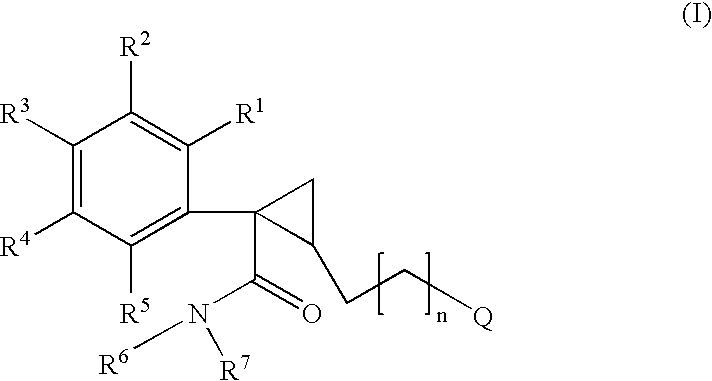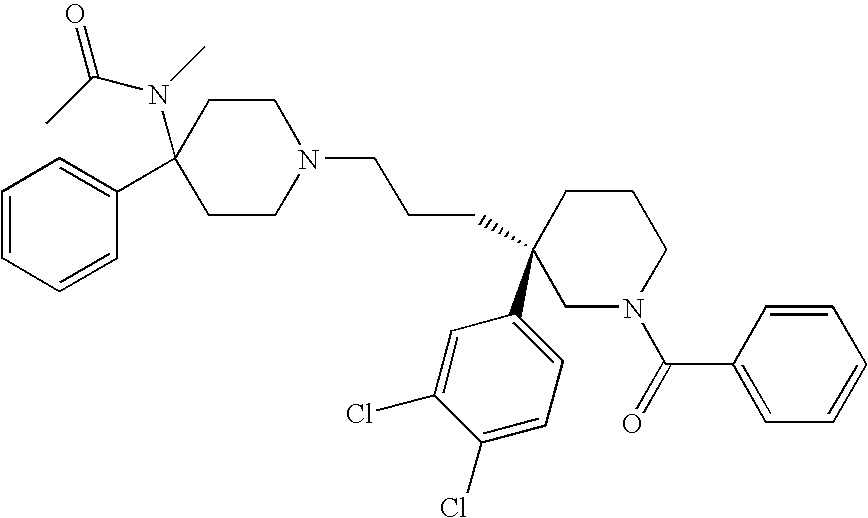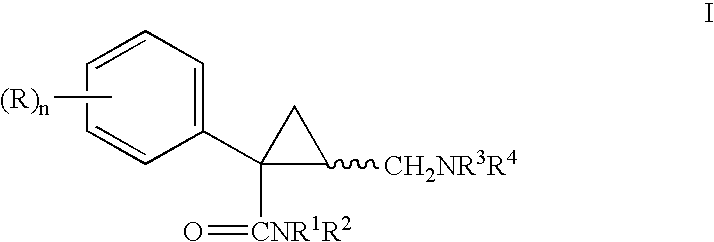Cyclopropyl derivatives as nk3 receptor antagonists
- Summary
- Abstract
- Description
- Claims
- Application Information
AI Technical Summary
Benefits of technology
Problems solved by technology
Method used
Image
Examples
example 1
Synthesis of racemic 1-(3,4-Difluorophenyl)-3-oxa-bicyclo[3.1.0]hexan-2-one
[0457] (3,4-Difluorophenyl)acetic acid (52 g; 0.3 mol) was dissolved in N,N-dimethylformamid (200 mL). Potassium carbonate (61 g, 0.45 mol) was added and the mixture was stirred at room temperature (rt) for 15 min. Allyl bromide (47 g, 0.39 mol) was added and the suspension was stirred at room temperature for 20 h. The mixture was thrown into water (250 mL) and extracted with diethylether (2×300 mL). The combined organic phases were washed with water (4×100 mL), dried (Magnesium sulphate) and evaporated in vacuo to give 64 g (3,4-Difluoro-phenyl)acetic acid allyl ester as a clear oil.
[0458] (3,4-Difluoro-phenyl)acetic acid allyl ester (64 g) was dissolved in acetonitrile (400 mL) and 4-acetamidobenzenesulfonyl azide (p-ABSA, 87 g, 0.36 mol) was added and the mixture stirred at room temperature for 15 min. The mixture was then cooled to 0° C. and 1,8-diazabicyclo[5.4.0]undec-7-ene (DBU, 58.6 mL) was added dr...
example 2
Synthesis of (1S,5R)-1-(3,4-Dichlorophenyl)-3-oxa-bicyclo[3.1.0]hexan-2-one
[0465] A solution of 3,4-dichlorophenylacetonitrile (62 g, 332 mmol) in benzene (250 mL) was added slowly to a suspension of sodium amide (28.1 g, 720 mmol) in benzene (250 mL) at 0° C. under argon, and the mixture was stirred at room temperature for 3 h. To the resulting mixture, a solution of (R)-epichlorohydrin (30.1 g, 288 mmol] in benzene (250 mL) was added at 0° C. during 45 minutes, and the whole was stirred at room temperature for 16 h. After the solvent was evaporated, EtOH (1250 mL) and 2 N NaOH (500 mL) were added to the residue, and the mixture was heated under reflux for 15 h and then acidified with 12 N HCl at 0° C. (pH of the mixture was about 1). The resulting mixture was evaporated, and AcOEt (900 mL) was added to the residue. Insoluble salts were filtered off, and the filtrate was washed with brine, dried (Na2SO4), and evaporated. The residue was purified by column chromatography (silica ge...
example 3
(1S,2R)-2-Hydroxymethyl-1-phenyl-cyclopropanecarboxylic acid benzyl-methyl-amide
[0479] To a solution of (1S,5R)-1-phenyl-3-oxa-bicyclo[3.1.0]hexan-2-one (10.5 g, 60.0 mmol) in CH2Cl2 (200 mL) was added AlCl3 (16.0 g, 120 mmol) and then the mixture was cooled to 0° C., and then benzyl methyl amine (240 mmol, as a 2.0M solution of benzyl methyl amine in THF) was added slowly. The mixture was stirred at room temperature for 24 h, and then the reaction was quenched with saturated aqueous NH4Cl. After addition of CH2Cl2 and H2O, the resulting mixture was partitioned. The organic layer was washed with 1N HCl and brine, dried (Na2SO4), evaporated, and purified by column chromatography (silica gel; AcOEt / hexane, 1:4) to give (1S,2R)-2-Hydroxymethyl-1-phenyl-cyclopropanecarboxylic acid benzyl-methyl-amide.
[0480] The following compounds were prepared in a similar way: [0481] (1S,2R)-1-(4-Chlorophenyl)-2-hydroxymethyl-cyclopropanecarboxylic acid benzyl methyl amide; [0482] (1S,2R)-1-(4-Fluor...
PUM
| Property | Measurement | Unit |
|---|---|---|
| Electrical conductance | aaaaa | aaaaa |
| Time | aaaaa | aaaaa |
| Composition | aaaaa | aaaaa |
Abstract
Description
Claims
Application Information
 Login to View More
Login to View More - R&D
- Intellectual Property
- Life Sciences
- Materials
- Tech Scout
- Unparalleled Data Quality
- Higher Quality Content
- 60% Fewer Hallucinations
Browse by: Latest US Patents, China's latest patents, Technical Efficacy Thesaurus, Application Domain, Technology Topic, Popular Technical Reports.
© 2025 PatSnap. All rights reserved.Legal|Privacy policy|Modern Slavery Act Transparency Statement|Sitemap|About US| Contact US: help@patsnap.com



